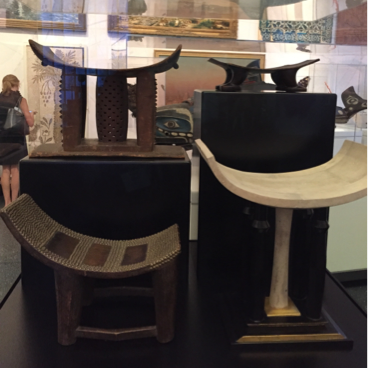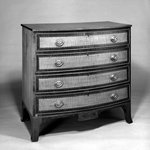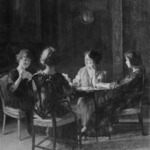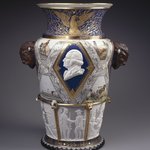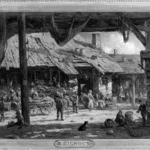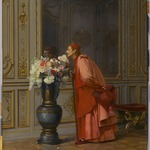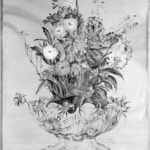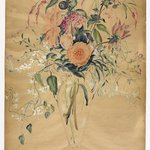

Pierre Legrain (French, 1889–1929). Stool (Tabouret), ca. 1923. Wood, shagreen (likely ray skin), laquer, gilding, 22 × 21 × 12 in. (55.9 × 53.3 × 30.5 cm). Brooklyn Museum, Purchased with funds given by an anonymous donor, 73.142. Creative Commons-BY (Photo: Brooklyn Museum, 73.142_bw_SL3.jpg)

Pierre Legrain (French, 1889–1929). Stool (Tabouret), ca. 1923. Wood, shagreen (likely ray skin), laquer, gilding, 22 × 21 × 12 in. (55.9 × 53.3 × 30.5 cm). Brooklyn Museum, Purchased with funds given by an anonymous donor, 73.142. Creative Commons-BY (Photo: Brooklyn Museum, 73.142_threequarter_SL3.jpg)
Stool (Tabouret)
Decorative Arts and Design
On View: Decorative Art, 20th-Century Decorative Arts, 4th Floor
European Art Deco designs borrowed heavily from other cultures, both past and present. Designers from countries that had extensive colonial holdings in Africa, Asia, and the South Pacific frequently appropriated forms and incorporated materials taken from these distant cultures.
The French Art Deco designer Pierre Legrain looked to traditional Asante, or Ashanti, stools for the form of this stool, modifying the African example by employing lavish materials including lacquered wood and sharkskin. The Asante are a people native to the Asante region of present-day Ghana, for whom stools have long been powerful symbols of authority, unity, and lineage. It’s unclear to what extent Legrain was aware of the Asante stool’s cultural significance. Although his design offers an example of masterful craftsmanship and inventive reinterpretation, it also poses problematic questions about cultural appropriation in the context of French imperialism, which justified exploitation of a sophisticated and established culture.
The French Art Deco designer Pierre Legrain looked to traditional Asante, or Ashanti, stools for the form of this stool, modifying the African example by employing lavish materials including lacquered wood and sharkskin. The Asante are a people native to the Asante region of present-day Ghana, for whom stools have long been powerful symbols of authority, unity, and lineage. It’s unclear to what extent Legrain was aware of the Asante stool’s cultural significance. Although his design offers an example of masterful craftsmanship and inventive reinterpretation, it also poses problematic questions about cultural appropriation in the context of French imperialism, which justified exploitation of a sophisticated and established culture.
MEDIUM
Wood, shagreen (likely ray skin), laquer, gilding
DATES
ca. 1923
DIMENSIONS
22 × 21 × 12 in. (55.9 × 53.3 × 30.5 cm) (show scale)



MARKINGS
no marks
SIGNATURE
no signature
INSCRIPTIONS
no inscriptions
COLLECTIONS
Decorative Arts and Design
ACCESSION NUMBER
73.142
CREDIT LINE
Purchased with funds given by an anonymous donor
CATALOGUE DESCRIPTION
Stool (tabouret), black lacquer and sharkskin over wood. U-shaped seat covered with sharkskin, supported by four polygonal columns lacquered black and a center column covered in sharkskin. Center column is narrow at center and flares toward top and bottom and rests on a flat square base covered with gold leaf. The outer lacquered columns are polygonal each with a flange beneath the seat. Rectangular base, tri-stepped on front and back and slopping at either end. Middle step covered with gold leaf base otherwise covered with black lacquer.
CONDITION - Good. All edges of parchment are worn.
EXHIBITIONS
MUSEUM LOCATION
This item is on view in Decorative Art, 20th-Century Decorative Arts, 4th Floor
CAPTION
Pierre Legrain (French, 1889–1929). Stool (Tabouret), ca. 1923. Wood, shagreen (likely ray skin), laquer, gilding, 22 × 21 × 12 in. (55.9 × 53.3 × 30.5 cm). Brooklyn Museum, Purchased with funds given by an anonymous donor, 73.142. Creative Commons-BY (Photo: Brooklyn Museum, 73.142_bw_SL3.jpg)
IMAGE
overall, 73.142_bw_SL3.jpg. Brooklyn Museum photograph
"CUR" at the beginning of an image file name means that the image was created by a curatorial staff member. These study images may be digital point-and-shoot photographs, when we don\'t yet have high-quality studio photography, or they may be scans of older negatives, slides, or photographic prints, providing historical documentation of the object.
RIGHTS STATEMENT
Creative Commons-BY
You may download and use Brooklyn Museum images of this three-dimensional work in accordance with a Creative Commons license. Fair use, as understood under the United States Copyright Act, may also apply.
Please include caption information from this page and credit the Brooklyn Museum. If you need a high resolution file, please fill out our online application form (charges apply).
For further information about copyright, we recommend resources at the United States Library of Congress, Cornell University, Copyright and Cultural Institutions: Guidelines for U.S. Libraries, Archives, and Museums, and Copyright Watch.
For more information about the Museum's rights project, including how rights types are assigned, please see our blog posts on copyright.
If you have any information regarding this work and rights to it, please contact copyright@brooklynmuseum.org.
RECORD COMPLETENESS
Not every record you will find here is complete. More information is available for some works than for others, and some entries have been updated more recently. Records are frequently reviewed and revised, and we welcome any additional information you might have.


